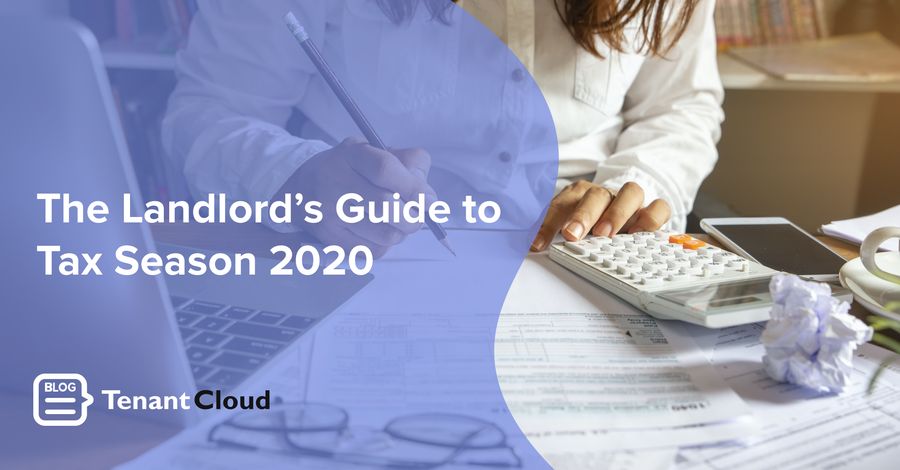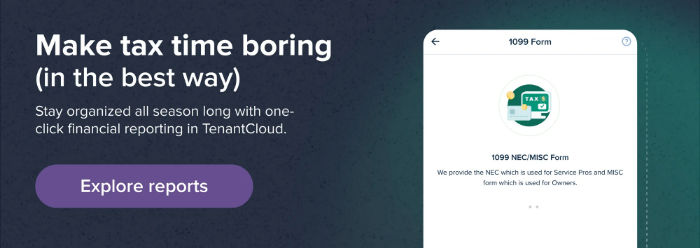Managing a rental property involves dealing with a wide range of tasks and responsibilities. Besides collecting rent and resolving tenant-related issues, a landlord is also required to file taxes properly. While this is a routine task for experienced landlords, beginners might find tax season to be quite stressful and overwhelming. As tax deadlines approach, developing a baseline understanding of how real estate taxation works should be every landlord’s first priority. In this article, we will outline some of the basics that will help you navigate tax season and introduce you to the deductions that can significantly reduce your taxes.

The basics of real estate taxation
Before delving deeper into how taxes are filed, you have to understand how landlords are taxed. Below is a brief overview of the taxes that you are required to pay when managing a residential rental property.
Income taxes on rental income: The rental income that you generate from a property is subject to income tax. When filing yearly tax returns, the net rental income is simply added to your other types of income. The federal government and most states use a system of progressive income tax rates that range from 10% to 37% of taxable income depending on how much you made.
Income taxes when selling a property: Profits that are earned through property sales are added to your yearly income as well. Taxes on these profits can be deferred indefinitely thanks to Section 1031 exchanges.
It’s important to note that some landlords can be subject to other types of taxes. For example, landlords who hire employees might have to pay social security and medicare taxes. Moreover, high-income landlords might also be affected by a 3.8% net investment income tax.
Understanding how ownership affects taxation
Landlords can utilize a wide range of legal vehicles when owning a property. Naturally, this affects the taxation of the rental activity. Here are the main ownership options that are available to you.
Sole ownership: This is the most straightforward approach to operating a rental property. Like we mentioned above, any income generated from the property is added to the owner’s yearly income.
Co-ownership: When it comes to taxation, co-owners are treated as sole proprietors. Each owner’s share of taxes is determined based on their ownership interest in the property.
Co-ownership by spouses: Spouses are treated as a single owner by the IRS. Married couples can file a single schedule E with their joint return.
General partnerships and limited partnerships: Landlords who own property through partnerships need to file an annual IRS tax form. More specifically, IRS form 1065. This document outlines the partnership’s profit and losses. Additionally, each partner needs to attach a Schedule K-1 to the 1065 form. The partners are also required to file Schedule E in order to show their individual income or losses from the partnership.
S corporations: Owning rental properties through these entities requires filing IRS form 1120-S. Furthermore, each shareholder must fill the second page of Schedule E.
LLCs: A limited liability company with a single member is subject to Schedule E and is treated the same way as sole ownership. As for LLCs with multiple members, the IRS treats them as partnerships.
What landlords can deduct on their taxes
Tax deductions are an integral part of operating a profitable real estate business. Leveraging them properly will allow you to offset the various costs that are inherent to rental properties. In any event, here are the main expenses that you can deduct from the gross rental income.
Operating expenses
The operating expenses that landlords can deduct have to be necessary, current, and directly related to the activity. Moreover, they have to be reasonable in amount. Examples of such expenses include maintenance, insurance, advertising, and broker commission.
Repairs
Deducting property repairs is an effective way to reduce your taxable income. However, it’s important to differentiate between repairs and improvements. Repairs are reasonable in amount and are necessary for maintaining the property in working condition whereas improvements are more expensive and cosmetic in nature.
Depreciation
Depreciation is the gradual decrease in property value. Landlords can deduct it on a yearly basis even if the price of the property appreciates.
Deductible interests
Landlords can deduct the interest on any money they borrow for their rental activity. This includes mortgage interests on acquisition and property improvement loans, interest on credit cards for goods or services used in the activity, and personal loans for any goods used in the rental business.
Start-up expenses
These are the initial costs that landlords incur when setting up a rental business. Start-up expenses cover everything from business license fees to home office expenses.
Travel expenses
Expenses stemming from any travel for your rental activity are deductible from the gross rental income. To benefit from this deduction, you must travel outside the city limit and stay away overnight.
Payments to workers
Any money you pay to a worker in your rental business is a deductible expense. Generally speaking, these payments can be classified as operating expenses, start-up expenses, or depreciation.
Losses from theft or casualty
Losses that you incur from an unexpected event such as a fire or vandalism can also be deducted. It’s worth noting that the repairs you undertake after a casualty event are depreciated as improvements.
Additional deductions
The scope of what landlords can deduct is quite wide and impossible to cover in a single section. Here are some of the other deductions that are available to you.
Subscription fees
Education expenses
Legal services
Meals and entertainment
Unpaid rent
How to file taxes as a landlord
Landlords who don’t own their property through a business entity have to file Schedule E to report rental income or deductions. Handling this much data can be tedious and time-consuming. Fortunately, there is a simple way to tackle this process. Thanks to the TenantCloud tax preparation report, landlords can stay organized and file their taxes in an efficient manner.
Overall, this is a fairly straightforward process that requires filling out the first page of the IRS form. Page 2 through 5 are reserved for partnerships, S corporations, and estate trusts. The first page of schedule E should be filled out as follows.
Line A: Answer «yes» if you have made any payments that require filing IRS form 1099. This form should be filed if the landlord had paid a contractor by cash or check more than $600. Form 1099 should also be filed if your rental activity is a business for tax purposes.
Line B: Answer «yes» if you have filed IRS form 1099.
Line 1: List the property’s address.
Line 2: List any properties that you have used for personal purposes during the year.
Line 3: Enter the total income that your property generated.
Line 4: Leave this blank if you haven’t received any royalty income from copyrights, patents, or mineral leases.
Lines 5-20: List all your property expenses for the year.
Lines 21-26: This section of schedule E serves as a rental summary for your rental activity. It covers the profit you made during the year or the loss you incurred.
The bottom line
This article should give you a basic idea of how to approach tax season. Still, there are many pitfalls that you have to watch out for when filing your taxes. If you still feel overwhelmed, remember- you can always hire an accountant to double check your work.
Landlord Tax Deductions: Software for Landlords by TenantCloud
Tax Season Tips Or About Software Application, Calculating Interest Expense And More
Make Your Tax Season Easier: Maximize Tax Deductions, Automate The Process







